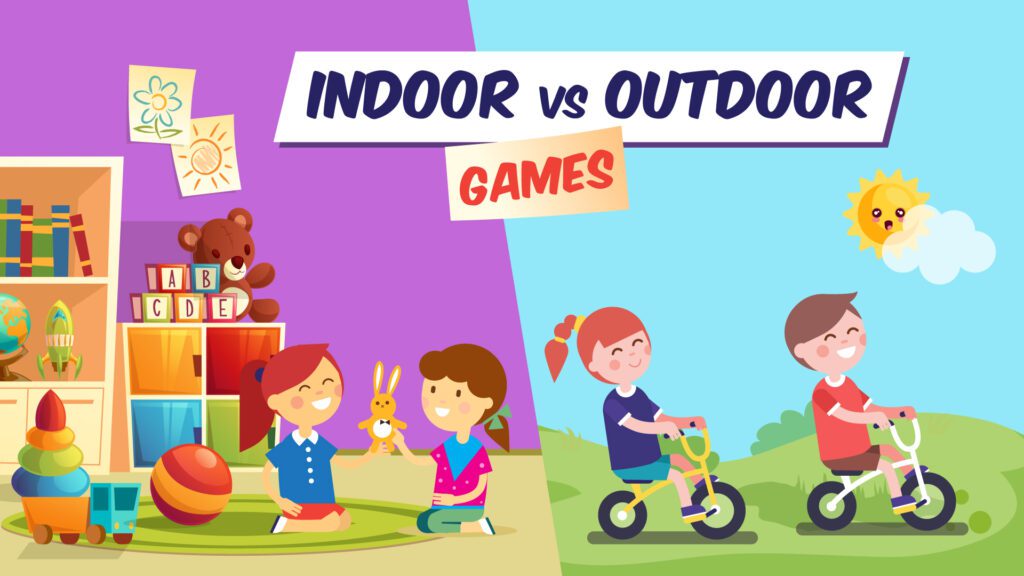Introduction
In today’s fast-paced digital age, children are increasingly exposed to a world of screens and indoor activities. While technology offers numerous benefits and opportunities for learning, it’s essential to maintain a healthy balance between indoor and outdoor activities to ensure a child’s holistic development. This blog explores the significance of striking the right balance between indoor and outdoor activities in fostering a child’s growth, both physically and mentally.
The Rise of Indoor Activities
The advent of the internet and digital technologies has drastically altered the way children spend their free time. The allure of video games, smartphones, and television has led to a significant increase in sedentary indoor activities. While these digital pastimes can be entertaining and even educational, an overreliance on them can have adverse effects on children’s well-being.
The Pitfalls of Excessive Indoor Time
- Physical Health Concerns: Prolonged periods of indoor activities can lead to a sedentary lifestyle, contributing to various health issues like obesity and muscular problems.
- Social Isolation: Excessive screen time can hinder a child’s social development as they may spend less time interacting with their peers.
- Mental Health Implications: An overindulgence in indoor activities can result in higher levels of stress, anxiety, and depression among children.
- Limited Creativity: Children who spend too much time indoors may have restricted opportunities for creative and imaginative play, which are essential for cognitive development.
The Benefits of Outdoor Activities
Outdoor activities provide a plethora of advantages for children’s growth and development. Here are some compelling reasons why children should spend more time outside.
Physical Health
- Physical Fitness: Outdoor activities like running, playing sports, and biking promote physical fitness and help in maintaining a healthy weight.
- Vitamin D: Exposure to sunlight is an excellent natural source of Vitamin D, crucial for bone development.
- Enhanced Motor Skills: Playing outdoors encourages the development of motor skills, agility, and coordination.
Mental and Emotional Well-being
- Stress Reduction: Being in nature and engaging in outdoor play can reduce stress and boost mental well-being.
- Creativity and Imagination: Natural settings provide an ideal environment for fostering creativity and imagination.
- Social Skills: Interacting with peers in an outdoor setting helps children develop essential social skills and build friendships.
Cognitive Development
- Exploration and Curiosity: Outdoor environments stimulate a child’s curiosity and encourage exploration, which are fundamental to cognitive growth.
- Problem-Solving: Activities like building forts, solving puzzles, and navigating outdoor spaces challenge children’s problem-solving skills.
Striking the Right Balance
Balancing indoor and outdoor activities is key to supporting a child’s overall growth. Here’s how parents and caregivers can strike the right equilibrium:
1. Set Screen Time Limits
Establish clear rules regarding screen time. Limit the use of electronic devices to a specific number of hours per day, ensuring that there’s ample time left for outdoor activities.
2. Encourage a Variety of Outdoor Activities
Introduce children to a variety of outdoor activities, such as hiking, biking, gardening, and team sports. This exposes them to different experiences and helps them discover their interests.
3. Join In
Participate in outdoor activities with your child. This not only strengthens the bond between you but also sets a positive example of an active lifestyle.
4. Create an Outdoor-Friendly Environment
Design your backyard or outdoor space to be enticing for kids. Add swings, a sandbox, or a small garden to encourage outdoor play at home.
5. Prioritise Safety
Ensure that outdoor activities are safe by supervising children when necessary, providing appropriate safety gear, and educating them about potential risks.
6. Be Flexible
Allow your child to have some say in choosing activities. This fosters independence and makes outdoor time more enjoyable.
7. Educate About Nature
Teach your child about the natural world. This can involve explaining the names of plants and animals, discussing environmental conservation, and nurturing a love for nature.
8. Plan Family Outdoor Adventures
Organize family outings to parks, beaches, and nature reserves. These trips offer a change of scenery and a break from routine.
9. Weather-Resilient Activities
Encourage outdoor activities in all seasons. Whether it’s sledding in winter or playing in the rain in spring, children can learn to appreciate nature in all its forms.
10. Embrace Unstructured Play
Allow children unstructured playtime outdoors. Sometimes, the best experiences come from letting them explore and create their own adventures.
Case Studies: Balancing Indoor and Outdoor Activities
Let’s explore a few case studies to see how striking the right balance between indoor and outdoor activities has positively impacted children’s growth.
Case Study 1: The Park Family
The Park family used to spend most of their weekends indoors, with each member engrossed in their devices. After realizing the need for a change, they decided to take up hiking as a family. They now spend weekends exploring nature, which has improved their fitness, strengthened their bond, and encouraged their children to appreciate the outdoors.
Case Study 2: The Greenfield School
Greenfield School integrated outdoor education into its curriculum. Students are encouraged to explore the school’s extensive garden and take part in outdoor science experiments. This approach has not only improved students’ academic performance but also fostered a sense of environmental responsibility.
Case Study 3: The Johnson Siblings
The Johnson family has a tradition of gardening, and the children have been actively involved in this outdoor activity since they were young. This has not only imparted them with horticultural knowledge but also helped develop their patience, responsibility, and teamwork.
Conclusion
Balancing indoor and outdoor activities is essential for children’s holistic growth. While indoor activities can provide valuable educational experiences, the benefits of outdoor play for physical, mental, and emotional development are undeniable. As parents, caregivers, and educators, it is our responsibility to strike the right equilibrium, fostering an environment where children can thrive both inside and outside. So, encourage your child to put down that tablet, step outside, and embrace the wonders of the natural world. The future development and well-being of our children depend on it.






127 responses
Can you be more specific about the content of your article? After reading it, I still have some doubts. Hope you can help me.
**mind vault**
mind vault is a premium cognitive support formula created for adults 45+. It’s thoughtfully designed to help maintain clear thinking